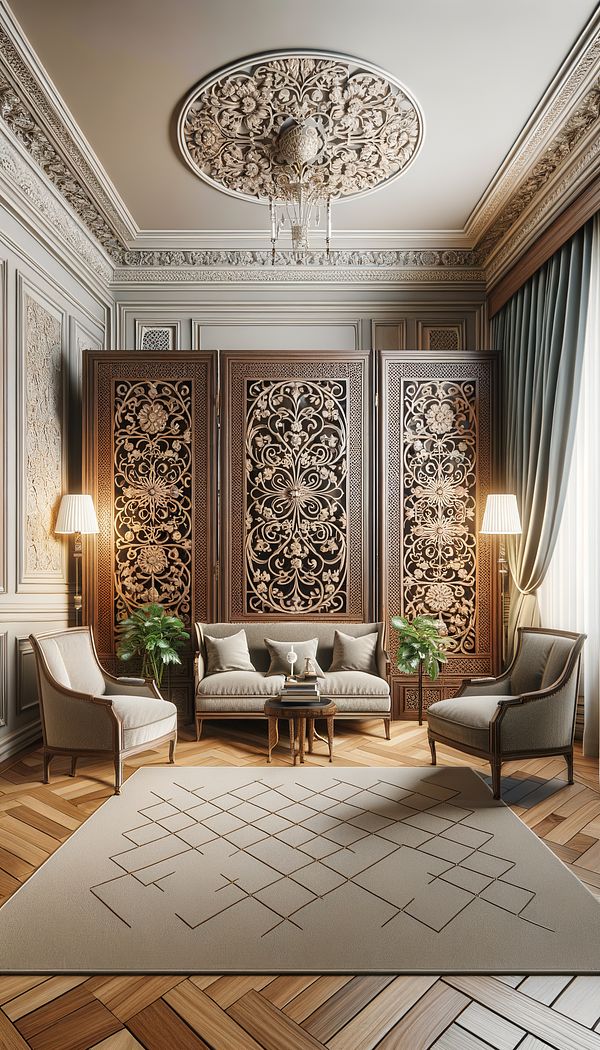What is Fretwork?
Fretwork is a decorative design carved into wood or metal.
Description
Fretwork is an intricate, often symmetrical, design that is carved into wood or metal, creating a pattern of interlocking lines, typically configured in geometrical and floral motifs. This decorative technique has been utilized in various cultures around the world for centuries, from the ornate latticework of Islamic architecture to the elaborate wooden screens and furniture of the Victorian era. Fretwork can be achieved using hand tools, such as fretsaws or jigsaws, allowing for precision cutting and the creation of detailed patterns.
The beauty of fretwork lies in its versatility; it can be incorporated into both architectural elements, such as balustrades, door panels, and window screens, as well as in furniture, mirrors, and decorative objects. Moreover, fretwork is not limited to traditional designs; contemporary interpretations can add unique, textured elements to modern interiors, blending well with various design styles. This artistic expression not only enhances aesthetic appeal but also serves functional purposes, such as promoting air circulation and light diffusion when used in screens and partitions.
Usage
Fretwork is widely used in interior design to add an element of visual interest and elegance to spaces. It finds its place in residential homes, traditionally in architectural elements such as room dividers and window treatments, as well as in commercial settings like hotels and restaurants, adding a touch of sophistication. Fretwork panels can also serve as decorative wall art, adding texture and pattern to an otherwise flat surface.
FAQs
-
Is fretwork only used with wood and metal?
Primarily, wood and metal are the most common materials for fretwork due to their durability and ease of carving. However, fretwork can also be found in modern materials like acrylics and MDF (Medium Density Fiberboard), offering more versatility in design and application.
-
Can fretwork be used outdoors?
Yes, fretwork can be used outdoors, especially when made from materials suited for exterior use, such as certain types of wood or metal that are treated to resist weather conditions. It's commonly seen in garden gates, fence panels, and outdoor furniture.
-
How is fretwork incorporated into modern design?
In modern design, fretwork is often used as a statement piece or a subtle texture element. Designers might incorporate fretwork in contemporary furniture, lighting fixtures, or as part of the room's architectural details to create a modern look with traditional craftsmanship.
Practical Application
When incorporating fretwork into interior design, consider the scale and design of the pattern in relation to the space and other elements within it. For a balanced look, choose a fretwork design that complements the room's overall decor. Additionally, given its intricate nature, maintaining cleanliness can be challenging, so placing fretwork in areas less prone to dust and grime can aid in upkeep. Using fretwork as focal points or accents can also significantly enhance the visual interest of any room without overwhelming the space.
-
Architectural Elements199 articles
-
Design Styles478 articles
-
Decorative Objects240 articles
-
Decorating Principles & Elements330 articles
-
Materials & Textiles360 articles
-
StrippingStripping in interior design refers to the process of removing layers of paint, wallpaper, varnish, or other coatings from surfaces.
-
Tudor RoseA traditional floral symbol of England, often used in architecture and design.
-
Zoom BackgroundA Zoom Background is a virtual background used in Zoom video calls.
-
AlmeryAn almery is a type of cupboard or cabinet.
-
DecoupageDecoupage is a decorative technique where cutouts are glued to a surface and then varnished.
